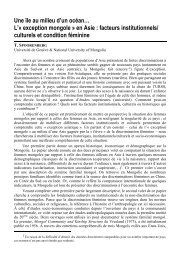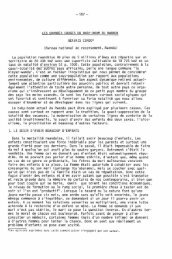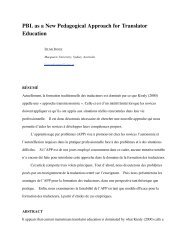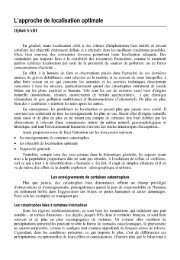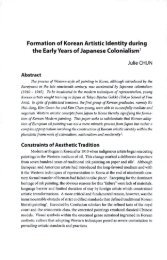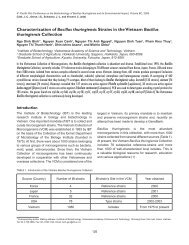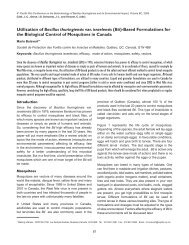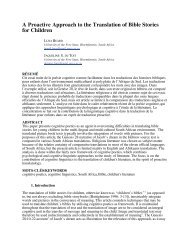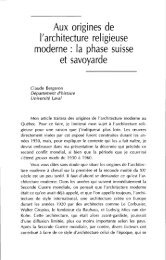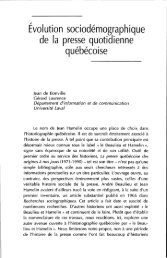Religious Art in Iran during the Qajar Epoch: Breaking the Boundaries
Religious Art in Iran during the Qajar Epoch: Breaking the Boundaries
Religious Art in Iran during the Qajar Epoch: Breaking the Boundaries
Create successful ePaper yourself
Turn your PDF publications into a flip-book with our unique Google optimized e-Paper software.
ACTES DU 8" COLLOQUE ÉTUDIANT DU DÉPARTEMENT D'HISTOIRE<br />
The <strong>in</strong>fluence of European art on <strong>Iran</strong>ian pa<strong>in</strong>t<strong>in</strong>g began <strong>in</strong> <strong>the</strong> Safavid epoch<br />
(1502-1736) 2 , but it affected <strong>the</strong> art of murals more than traditional Persian manuscript<br />
illum<strong>in</strong>ation. In that period, <strong>the</strong> art of <strong>the</strong> Italian Renaissance, as well as Dutch<br />
Baroque pa<strong>in</strong>t<strong>in</strong>g, were <strong>in</strong>troduced to <strong>Iran</strong>ian artists and <strong>the</strong>ir patrons, and <strong>the</strong> demand<br />
for this new art <strong>in</strong>creased. These certa<strong>in</strong> artistic styles from Europe gave<br />
artists <strong>the</strong> opportunity to experiment with three-dimensional representation, <strong>the</strong><br />
use of light, <strong>the</strong> shape of a human body, and l<strong>in</strong>ear perspective to <strong>in</strong>dicate depth as<br />
seen <strong>in</strong> European pa<strong>in</strong>t<strong>in</strong>gs. The pa<strong>in</strong>t<strong>in</strong>gs and murals of <strong>the</strong> Safavid era, <strong>the</strong>refore,<br />
are constructive examples of <strong>the</strong> first l<strong>in</strong>ks between European pa<strong>in</strong>t<strong>in</strong>gs and <strong>Iran</strong>ian<br />
image mak<strong>in</strong>g followed by artists of <strong>the</strong> <strong>Qajar</strong> period extensively. In <strong>the</strong> 1620s, as <strong>the</strong><br />
presence of European travelers and artists <strong>in</strong> Isfahan, <strong>the</strong> Safavid capital, <strong>in</strong>creased,<br />
so did <strong>the</strong> number of commissions for European-style realistic pa<strong>in</strong>t<strong>in</strong>gs and murals.<br />
The murals of <strong>the</strong> Safavid epoch also show <strong>the</strong> <strong>in</strong>spiration of European art<br />
specifically on religious art. Dur<strong>in</strong>g this period, Armenians were brought from <strong>the</strong><br />
Turkish borders and settled <strong>in</strong> Isfahan by Shah Abbas I (1587-1629 A.D.) to protect<br />
<strong>the</strong>m from Turkish <strong>in</strong>cursions'. Armenian merchants who traveled to Europe<br />
brought back numerous pieces of artwork, many of which are still on display <strong>in</strong> <strong>the</strong><br />
Vank Museum, <strong>in</strong> <strong>the</strong> Jolfa suburb of Isfahan. These pa<strong>in</strong>t<strong>in</strong>gs <strong>in</strong>clude portraits<br />
and figures, landscapes and still lifes <strong>in</strong> <strong>the</strong> Italian Renaissance style. Pa<strong>in</strong>ted <strong>in</strong> oil,<br />
most canvases are religious portrayals of Christ and <strong>the</strong> Virg<strong>in</strong> Mary, pa<strong>in</strong>ted and<br />
purchased <strong>in</strong> Europe by Armenian traders, who would <strong>in</strong> turn donate <strong>the</strong>m to <strong>the</strong><br />
churches <strong>in</strong> Isfahan 4 . Eventually, <strong>the</strong> pa<strong>in</strong>t<strong>in</strong>gs became effective models for <strong>Iran</strong>ian<br />
artists and helped <strong>the</strong>m become familiar with new techniques, especially oil on canvas.<br />
In addition, <strong>the</strong> walls of <strong>the</strong> churches that were built <strong>in</strong> <strong>the</strong> Safavid era, such<br />
as Betlaham Church (built <strong>in</strong> 1628), Vank Ca<strong>the</strong>dral (built <strong>in</strong> 1655), and George<br />
Church (completed <strong>in</strong> 1719), were covered with murals depict<strong>in</strong>g <strong>the</strong> life of Christ,<br />
<strong>the</strong> Virg<strong>in</strong> Mary, and Judgment Day 5 .<br />
One example is <strong>the</strong> murals on <strong>the</strong> walls and ceil<strong>in</strong>gs of Vank Ca<strong>the</strong>dral attributed<br />
to an <strong>Iran</strong>ian-Armenian artist named M<strong>in</strong>as, who was born <strong>in</strong> <strong>the</strong> first half<br />
of <strong>the</strong> seventeenth century. Dur<strong>in</strong>g his childhood, M<strong>in</strong>as's family moved to Halab,<br />
Syria, where he was tra<strong>in</strong>ed by a European artist. After return<strong>in</strong>g to Isfahan, he was<br />
commissioned to provide murals for palaces and merchants' houses and became<br />
<strong>the</strong> chief pa<strong>in</strong>ter of <strong>the</strong> murals <strong>in</strong> <strong>the</strong> Betlaham Church 6 . The Church murals were<br />
probably pa<strong>in</strong>ted around <strong>the</strong> 1640s 7 . S<strong>in</strong>ce both <strong>the</strong> technique used and some images<br />
pa<strong>in</strong>ted <strong>in</strong> Betlaham Church are very similar to <strong>the</strong> ones <strong>in</strong> Vank Ca<strong>the</strong>dral, it<br />
is more than likely that M<strong>in</strong>as pa<strong>in</strong>ted <strong>the</strong> walls of <strong>the</strong> Vank Ca<strong>the</strong>dral, as well. As<br />
seen <strong>in</strong> Figure 1, <strong>the</strong> figures are pa<strong>in</strong>ted wear<strong>in</strong>g green, red, or brown Roman-style<br />
robes or <strong>the</strong>y are nude. The angels are dist<strong>in</strong>guished by w<strong>in</strong>gs and <strong>the</strong> figures of <strong>the</strong><br />
Virg<strong>in</strong> Mary and Christ are pa<strong>in</strong>ted with gold halos beh<strong>in</strong>d <strong>the</strong>ir heads. God, who<br />
120



